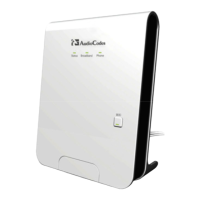User's Manual 9. Configuring VoIP Parameters
Version 4.4.0 103 MP26x/MP27x
Table 9-5: Media Streaming Tab Parameters Description
Parameter Description
Media Streaming Parameters
Local RTP Port Range -
Contiguous Series of 8
Ports Starting From:
Defines the port range for Real Time Protocol (RTP) voice transport.
DTMF Relay RFC 2833
Payload Type
Defines the RTP payload type used for RFC 2833 DTMF relay packets.
range is 0-255. The default is 101.
G.726/16 Payload Type
Defines the RTP payload type used for 16 kbps G.726 packets. The range
is 0-255. The default is 98.
Quality of Service Parameters
Type of Service (Hex)
This is a part of the IP header that defines the type of routing service to be
used to tag outgoing voice packets originated from the device. It is used to
inform routers along the way that this packet should get specific QoS.
Leave this value as 0xb8 (default) if you are unfamiliar with the
Differentiated Services IP protocol parameter.
Codecs
1
st
- 6
th
Codec
Defines the voice codec. For more information, see 9.3.1 on page 103.
9.3.1 Configuring Codecs
Codecs define the method of relaying voice data. Different codecs have different
characteristics, such as data compression and voice quality. For example, G.723 is a
codec that uses compression, so it is good for use where bandwidth is limited but its voice
quality is not as good compared to other codecs such as the G.711.
9.3.1.1 Supported Codecs
To make a call, at least one codec must be enabled. Moreover, all codecs may be enabled
for best performance. When you start a call to a remote party, your available codecs are
compared against the remote party's to determine the codec used. The priority by which
the codecs are compared is according to their order of appearance in the table
(descending order). To change the priorities, rearrange the codecs in the required order.
If there is no codec that both parties have made available, the call attempt fails. Note that if
more than one codec is common to both parties, you cannot force which of the common
codecs that were found are used by the remote party's client. If you do wish to force the
use of a specific codec, leave only that codec checked.
9.3.1.2 Packetization Time
The Packetization Time is the length of the digital voice segment that each packet holds.
The default is 20 millisecond packets. Selecting 10 millisecond packets reduces the delay
but increases the bandwidth consumption.

